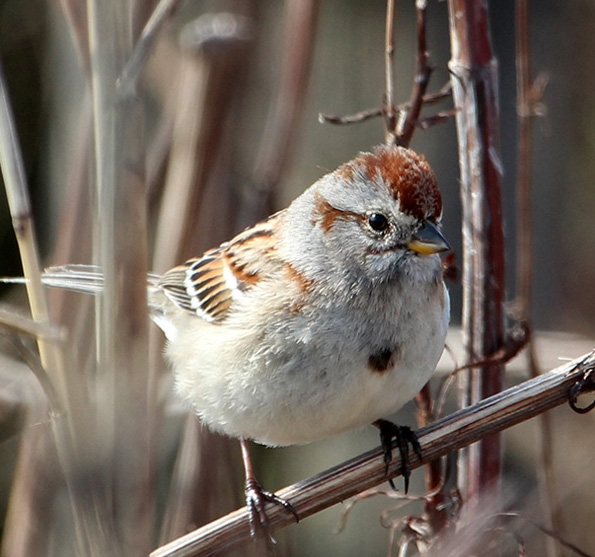
By John Shackford
There is an element of fun for me in identifying an American Tree Sparrow (Spizella arborea); it has to do with the bill. Usually I see the rufous cap first which narrows the choices down considerably. Then I see the 2-toned bill—dark above and yellow below—and immediately the identification becomes clear. It is a Tree Sparrow. It is always a little surprising to me what a consistently good identification point this is.
We in Oklahoma are on the southern edge of the species’ wintering ground. With global warming, we tend to see fewer and fewer of this species each year on our Oklahoma City Christmas Bird Count (CBC)—they apparently are just not regularly coming this far south anymore. Jimmy Woodard and Ted Goulden and their CBC parties saved us on this year’s count—they found 2 each. Thanks, Jimmy and Ted!
In Bent’s Life History on the American Tree Sparrow, it discusses the Tree Sparrow’s name, which is something of a misnomer; “…few birds spend less time in trees, either summer or winter…”; actually the Tree Sparrow “might more accurately be called brush sparrow; for its haunts include the shrubby edges of our fields, and marshes, hedgerows, and fallow fields” (Bent, A.C., 1968. Life histories of North American Cardinals, Grosbeaks, Buntings, Towhee, Finches, Sparrows, and allies,” as written by the author of this life history for Bent, Oklahoma’s own Dr. A. Marguerite Baumgartner. Apparently, to our forefathers, the American Tree Sparrow was reminiscent of the Eurasian Tree Sparrow they had known in Europe and accordingly named ours a Tree Sparrow too, even though the two sparrow are not that closely related—the genus of ours is Spizella, a true sparrow, while that of the European bird is Passer, a weaverbird, related more closely to the House Sparrow.
As mentioned above, the American Tree Sparrow has a very close association with Oklahoma: the Bent life history for the species was written by Dr. A. Marguerite Baumgartner. She and her husband, Dr. Fred M. Baumgartner are the authors of “Oklahoma Bird Life” (1992. University of Oklahoma Press, Norman, OK). Both Drs. Baumgarterners graduated with doctorates in zoology from Cornell University. I was surprised to learn that Marguerite did her doctoral thesis on the American Tree Sparrow. The circumstances are interesting. As she was working on her thesis she contacted A.C. Bent to find out what he knew about the species life history, particularly during the nesting season. Bent replied that “it is regrettable that you (Marguerite) did not select a bird you could study in the field yourself.” (from Bent’s Life histories, as cited above). Marguerite responded by arranging to spend the next two summers (1933 and 1934) in Churchill, Manitoba, in Canada, studying the breeding habits of the American Tree Sparrow. She found, and closely watched, 26 nests during the two summers she was in Churchill. The Tree Sparrow lays 3-6 eggs, usually 3-5, in a nest on or near the ground, with a very few exceptions up to 4 feet high, in dwarf willows. It strikes me as remarkable that Marguerite arranged funding for her research in Churchill; this was, after all, during the middle of the great depression of the 1930s.
Then in 1939, I believe, the Baumgartners moved to Stillwater, Oklahoma, where Fred was a professor from then until 1965; Marguerite raised five children, if I remember correctly and continued studying the winter habits of the Tree Sparrow, banding over 200 of them in Stillwater. One very interesting thing she learned was that in winter, female Tree Sparrows, apparently being less hearty than males, tended to migrate further south than males. Her sex ratios for Oklahoma heavily favored females, approaching 2.7 females for every male.
The Baumgartners did other things for birds in Oklahoma. For many years, I believe, Marguerite wrote a column on birds for the Daily Oklahoman. They helped organize many field expeditions, like Thanksgiving Safaris to see the Whooping Cranes at Aransas National Wildlife Refuge in Texas, and if memory serves, I believe they were instrumental in getting the Scissor-tailed Flycatcher designated as the State Bird of Oklahoma.
In reading about the American Tree Sparrow, I realized for the first time how much Marguerite had contributed to the scientific understanding of this sparrow. Although the Baumgartners are no longer living, we owe them a big thanks for advancing the study of birds in Oklahoma!
